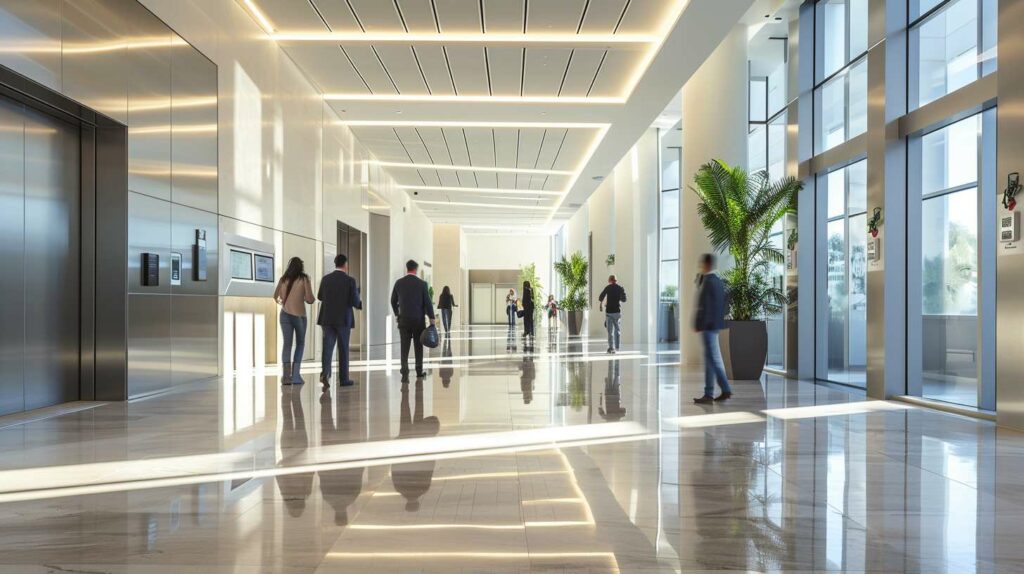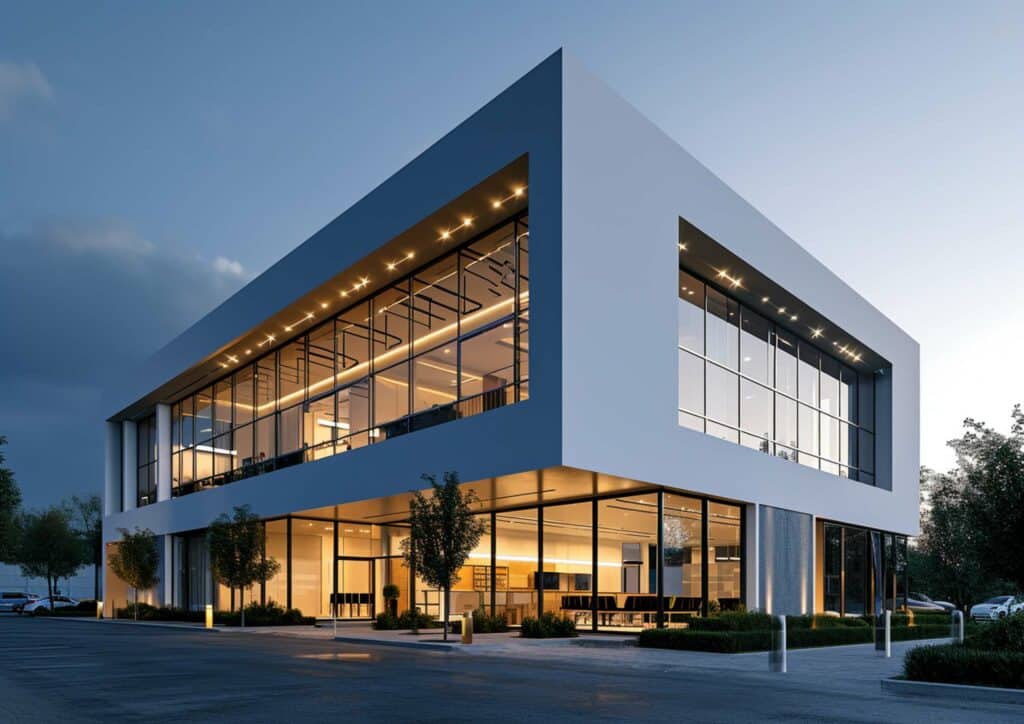Commercial buildings are more than just workplaces or retail spaces; they are a significant nexus of energy consumption, financial considerations, and environmental impacts. The importance of energy efficiency in commercial buildings cannot be overstated. It’s a critical aspect that affects everything from bottom-line cost savings to global environmental sustainability. Moreover, energy-efficient buildings are increasingly becoming the standard, with regulatory compliance adding another layer of urgency for property owners and managers to upgrade and improve their building systems.
Understanding Energy Efficiency
Energy efficiency in commercial real estate refers to using less energy to perform the same function. This means buildings are designed, retrofitted, or operated to maximize energy use, which results in lower energy costs and reduced environmental impact. For example, switching to LED lighting or updating HVAC systems to more energy-efficient models are tangible steps that can significantly reduce energy consumption while maintaining or improving service quality.
What is the difference between energy efficiency and energy conservation?
While they are often used interchangeably, energy efficiency and energy conservation are distinct concepts with different impacts on commercial buildings. Energy efficiency is about getting the most service for the least energy. It involves implementing technology or systemic changes that allow for the same level of service—be it lighting, heating, or cooling—but with less energy. Examples include the installation of LED lighting fixtures or high-efficiency HVAC systems that require less energy to operate.
On the other hand, energy conservation is about reducing the need for energy through changes in behavior and usage patterns. It can be as simple as turning off lights and electronic devices when not in use or setting back thermostats during off-hours. While both practices reduce energy use and can lower costs, energy efficiency is often seen as more sustainable, as it relies on technological improvements rather than solely on behavioral changes.

Statistical data underscores energy efficiency’s profound impact on operational costs and return on investment (ROI). According to the U.S. Energy Information Administration’s Commercial Buildings Energy Consumption Survey (CBECS), commercial buildings 2018 consumed a total of 926 billion kilowatt-hours (kWh). This level of consumption represents millions of dollars in energy costs that could be mitigated through energy efficiency measures. The report suggests that businesses have a substantial opportunity to reduce their operational costs by investing in energy efficiency upgrades, with the potential to reduce energy consumption significantly. By doing so, they save on energy costs and enjoy the benefits of improved building performance, increased asset value, and enhanced occupant comfort—all of which contribute positively to the ROI.
This data is a stark reminder that energy efficiency is not just environmentally responsible; it is also a sound financial strategy that can lead to significant savings and increased competitiveness in the market.
Financial Incentives for Energy Efficiency
The potential for cost savings through energy efficiency is further magnified when considering the range of financial incentives available to commercial properties. Tax incentives and deductions have been established to encourage the adoption of energy-efficient practices in the retail sector, offering a fiscal boon to those willing to invest in greener infrastructure.
What is the energy-efficient commercial building deduction for 2024?
For 2024, the energy-efficient commercial building deduction, often referred to as Section 179D of the tax code, has continued to provide a significant incentive for property owners and managers. This provision allows for an immediate deduction for costs incurred to make a commercial building more energy-efficient. To qualify, the upgrades must surpass the ASHRAE (American Society of Heating, Refrigerating, and Air-Conditioning Engineers) standard by a certain percentage of energy cost savings.
The specific details of the deduction can vary based on legislative changes, so businesses must consult with a tax professional to understand the current requirements and benefits. However, case studies have illustrated the financial benefits of such deductions, often showing that the initial cost of energy-efficient upgrades can be significantly offset by tax savings, lowering the overall investment and accelerating the ROI.
Which buildings get the partial energy efficiency tax credit?
The partial energy efficiency tax credit is generally awarded to commercial buildings that can demonstrate a measurable and significant reduction in energy usage. The eligibility criteria typically include a requirement that the building’s energy usage must be a certain percentage below the baseline set by the local or national standards for energy consumption.
The process for applying for and receiving this tax credit involves an energy audit by a certified professional, submission of detailed energy consumption data, and adherence to stringent documentation guidelines. Successful applicants will receive a credit that can reduce their tax liability, thus incentivizing the move towards more sustainable business practices.
Energy-Efficient Technologies in Commercial Buildings

Investing in high-ROI energy-efficient technologies is a strategic move for commercial building owners looking to reduce operational costs and benefit from financial incentives.
What are the energy-efficient appliances for commercial buildings?
Commercial buildings can save significant energy by upgrading to energy-efficient appliances. Top appliances and systems for substantial energy savings include:
- An energy-efficient HVAC system with high SEER (Seasonal Energy Efficiency Ratio) ratings.
- LED lighting fixtures that use at least 75% less energy than traditional incandescent lighting.
- High-efficiency motors for elevators and escalators use advanced designs to reduce energy consumption.
- Programmable thermostats that optimize heating and cooling schedules.
- Energy Star-rated office equipment that reduces energy use without sacrificing performance.
The benefits of upgrading to these energy-efficient models are multifold, including reduced energy bills, potential tax credits and deductions, improved equipment lifespan, and decreased maintenance costs due to these advanced systems’ higher quality and durability.
What are the energy-efficient insulation materials for commercial buildings?
Insulation plays a crucial role in maintaining a building’s temperature, and the choice of material can substantially impact energy efficiency. Some of the top energy-efficient insulation materials include:
- Polyurethane foam that provides high R-values per inch.
- Fiberglass batts that are cost-effective and widely available.
- Spray foam insulation that can seal air leaks and insulate simultaneously.
- Rigid foam boards that add insulation to walls and roofs without a significant increase in thickness.
The Process and Impact of Energy Audits
Energy audits are foundational in driving energy efficiency in commercial buildings. These audits highlight how businesses can reduce energy consumption and improve operational efficiency by systematically evaluating energy use. Companies like WattLogic specialize in conducting comprehensive energy audits, providing a clear roadmap for energy savings and sustainability.
What is an energy audit and why is it important?
An energy audit is a detailed examination of how a commercial building consumes energy. The audit analyses energy flows for energy conservation in a building to reduce the amount of energy input without negatively affecting the output. This includes reviewing historical energy usage data, evaluating the performance of existing systems, and identifying areas where improvements can be made.
Regular audits are essential as they help building owners understand the operational dynamics of their properties and pinpoint areas for cost-saving energy reductions—an energy-efficient building costs less to operate and increases in asset value over time. WattLogic, through its energy audits, has helped many businesses uncover hidden costs and identify strategies for reducing energy expenditure.
What are the energy-efficient energy audits for commercial buildings?

Energy-efficient energy audits for commercial buildings involve using the latest methods and technologies to collect and analyze data. Energy auditors often utilize state-of-the-art diagnostic tools such as infrared cameras, light meters, power monitoring tools, and advanced software analytics to assess a building’s energy performance accurately.
Interpreting the results from these audits is key to implementing effective energy-saving measures. WattLogic provides detailed reports that outline specific recommendations for improvements, such as upgrading to LED lighting or installing energy management systems. Our team can guide building owners on prioritizing and implementing these recommendations to achieve the best return on investment.
The Health and Environmental Benefits of Energy Efficiency
How does energy efficiency improve indoor air quality?
Investing in energy efficiency leads to healthier indoor environments. Like HVLS fans recommended by WattLogic, energy-efficient systems are designed to provide better ventilation and temperature control, directly improving indoor air quality. Efficient HVAC systems, for example, can reduce the presence of indoor pollutants, thus minimizing health risks related to poor air quality. Research has shown that such improvements can reduce asthma symptoms and allergies among building occupants.
The broader environmental advantages of pursuing energy efficiency in buildings
The pursuit of energy efficiency in commercial buildings has far-reaching environmental benefits. By reducing energy consumption, energy-efficient buildings are crucial in decreasing greenhouse gas emissions, a primary driver of climate change. These buildings require less energy from power plants, emitting fewer atmospheric pollutants.
WattLogic’s commitment to energy efficiency is demonstrated through its success stories, where buildings have achieved significant cost savings and contributed to sustainability goals.
Best Practices and Emerging Trends
Implementing energy efficiency strategies in commercial buildings is not just choosing the right technologies; it’s about integrating these solutions into a comprehensive approach that ensures long-term sustainability and cost savings. Here’s how businesses can effectively apply these strategies:
- Assess and Prioritize: Begin with a thorough energy audit from a trusted provider like WattLogic to identify the most significant opportunities for savings.
- Invest Smartly: Prioritize investments based on the potential for energy savings and return on investment (ROI). Start with low-hanging fruits that promise quick returns, such as lighting upgrades, before moving on to larger projects like HVAC overhauls.
- Engage Stakeholders: Keep all stakeholders informed and engaged, from investors and building owners to facility managers and everyday users. Their cooperation is critical for the successful implementation and adoption of energy-saving practices.
- Focus on Training: Ensure staff are trained to use new systems effectively and maintain an energy-conscious mindset in their daily operations.
Current and future trends in energy efficiency for commercial buildings

Commercial buildings are rapidly evolving with the integration of new energy technologies and trends:
- Renewable Energy: Incorporating renewable energy sources like solar and wind is becoming more financially feasible and is encouraged by various incentives. Buildings increasingly use onsite generation to offset energy consumption and reduce reliance on the grid.
- Smart Building Tech: Smart building technologies and the Internet of Things (IoT) are revolutionizing the operations of commercial buildings. Advanced sensors, automation systems, and data analytics can optimize energy usage in real time, adapting to the occupancy and usage patterns of the building.
- IoT Integration: IoT devices are becoming more prevalent in commercial buildings, allowing for the remote monitoring and management of energy systems, which leads to more efficient operation and maintenance.
Conclusion
In conclusion, energy efficiency in commercial buildings is a multifaceted endeavor that combines advanced technologies, strategic planning, and human engagement to create cost-effective and environmentally friendly environments. The benefits of energy efficiency are clear, from reduced operating costs to improved occupant health and a lower carbon footprint.
Taking action to improve energy efficiency is a step towards future-proofing your commercial assets. WattLogic’s team of energy consultants is well-equipped to assist businesses in navigating this journey. With a comprehensive approach that includes audits, detailed proposals, and guidance on taking advantage of rebates and incentives, WattLogic is your partner in achieving energy efficiency. Whether you’re looking to start with a simple upgrade or aiming for a complete overhaul of your energy systems, WattLogic can provide the expertise and support needed to make informed decisions and see tangible results.




